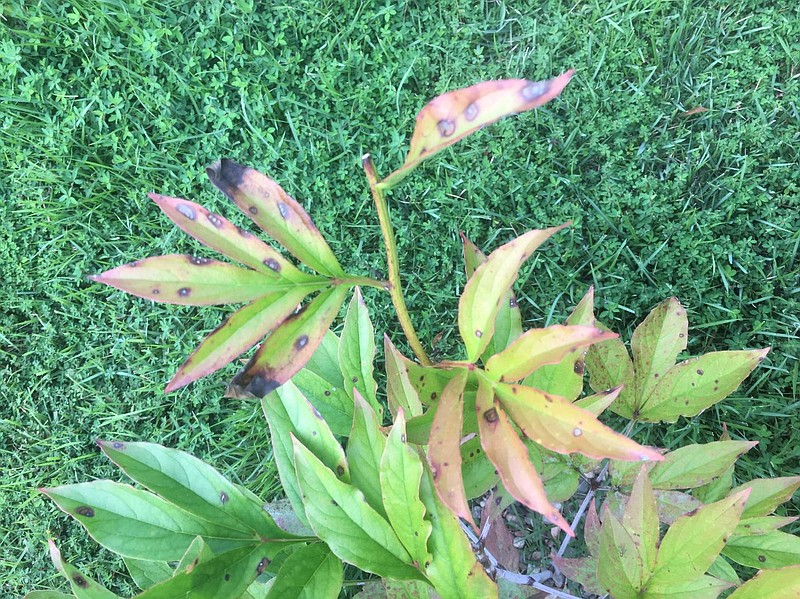Q. What disease is this on my peonies (see photo)? Should I be concerned about it, and what do I do to stop it?
A. Missouri Botanical Garden has a nice description of the different peony problems. Your photo most closely matches peony blotch (also called red spot or measles). This fungal disease occurs in spring just before blooming and affects all above ground parts. Small, circular red or purplish spots first appear superficially on the upper surface of young leaves. Later, they coalesce into large, glossy, irregular dark purple blotches, while the underside of the spots becomes a dull chestnut brown. Short reddish-brown streaks appear on the young stems and petioles. Eventually the whole plant may have purplish or brownish red spots.
Although not immediately lethal, repeated bouts for several years will affect plant vitality. It does not cause early leaf drop or stem dieback, but it causes the plant to be unsightly and lose its attractiveness as spots coalesce to form blighted areas.
Cultural way to lessen it is to remove all foliage to ground level each fall and destroy. Infected debris should not be added to the compost pile. To prevent in the spring, when the shoots are 24 inches high and the weather is cool, overcast and damp, spray weekly with a fungicide until the flowers open. Reapply following rain or overhead watering. Mancozeb is labeled for this, but check other broad-spectrum fungicides, especially if you have some on hand.
Q. I see that emerald ash borer is expected to kill many ash trees now that it has been found throughout Mid-Missouri. I have a fringe tree and see it is also in the same family as ash trees. Will fringe trees also be damaged?
A. Everything I have seen on emerald ash borer is that it is specific to ash. There are quite a number of ash species from the Genera Fraxinus. Fringe tree is from a different genus, Chionanthus. I'm glad to hear you planted a fringe tree. They are considered a very nice small ornamental tree with great smelling flowers in the spring, which are also quite pretty. As a Missouri native, they are associated with moist soil areas, so look after keeping watered if planted in the full sun. In part shade, they will tolerate dry conditions better.
Q. My tomatoes just aren't growing good this year. I didn't get much canopy, and the fruit are now exposed to the sun. I know that causes them to have sunburn, but they also seem to rot quickly. What can I do to salvage this year's planting to get some decent tomatoes this year?
A. The cool spring and early summer resulted in some plants not producing enough foliage to then shade the fruit. Once some fruit is set, the tomatoes direct their energy there and yet less foliage forms. Another factor is abundant rainfall, which could have leached away the nitrogen.
The fix is to get some nitrogen to the plants and apply a broad-spectrum fungicide to reduce the fruit rot that is occurring. The best combination spray is to use a copper fungicide and a fungicide containing the active ingredient chlorothalonil (e.g. Daconil). Always include a spreader sticker with your spray solution, and read and follow any label instructions. Side dressing the tomatoes with a dry/granular form of nitrogen or using compost will help the plants put forth some new foliage and stimulate stronger blooms. The good news is new tomatoes formed will ripen when the sunlight level and heat is substantially less, so yellow shoulders, hard core and other exposed fruit problems will diminish toward the end of August.

